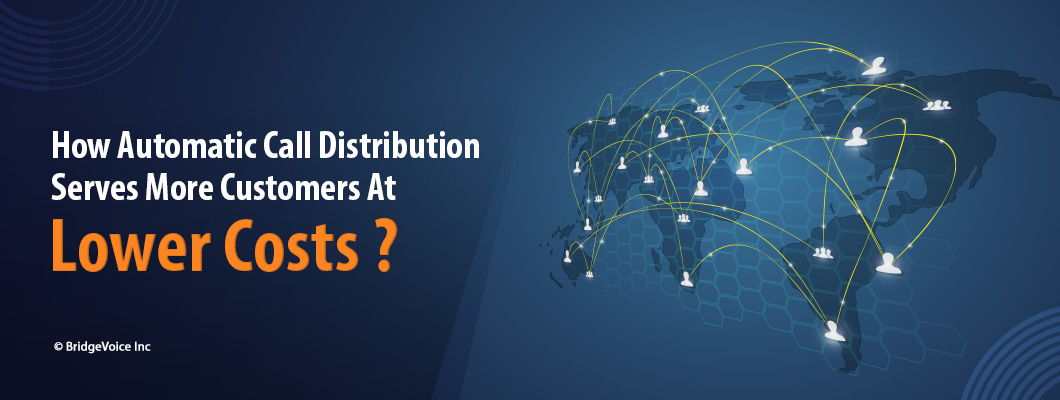How Automatic Call Distribution Serves More Customers at Lower Costs

Businesses where customer service is critical to the company’s success, especially call centers, are bound to deal with plenty of callers daily. Without dedicated contact center tools, call agents may find it challenging to deliver prompt service to customers. Besides, consumers expect them to resolve their concerns on the first try itself. If failed to resolve, customers may even seek other brands.
Automatic Call Distribution (ACD) can help overcome these challenges by eliminating long waiting periods and routing calls to the right agent. Along with enhancing customer experience, it boosts the morale and productivity of agents, resulting in optimized business communication.
Companies across the globe are putting $4.7 trillion of sales at risk every year due to poor customer experiences. According to a study, 53% of consumers have cut spending after a single bad experience with a company. As a response to this, call centers are increasingly adopting cloud-based communication systems with ACD for agent performance optimization. The cloud-based contact center market is forecasted to reach $45.5 billion by 2030 at a CGAR of 24.8% during the forecast period, 2021-2023.
What Is Automatic Call Distribution?
ACD is a telecommunication system that routes incoming calls in an inbound call center. The calls are directed to the right agent or a particular department based on preset rules and distribution criteria. ACD helps contact centers manage large call volumes and boost customer satisfaction.
How Does ACD Work?
The ACD system evaluates the inbound call details, call center agent availability, and other data sources to decide where to direct it. The routing of calls by ACD comprises three main steps:
- Identifying the caller and the purpose of the call according to predetermined criteria, such as Dialed Number Identification Service (DNIS)
- Sorting phone calls in the correct queue depending on factors like agent status, call type, caller wait time, and customer data
- Voice termination and call handling, or offering a callback option based on current call queue volume, saving customer’s place in line
Below are the common influencing factors for accurate caller identification and routing:
- Specific business phone numbers
- Area code and other caller information collected via Direct Inward Dialing (DID), caller ID, and DNIS
- Caller’s preferred language
- Time of the day
- Whether the caller is labeled as a VIP client or not
- IVR options selected by the caller, if any
Salient Features of ACD
- Skill-based Routing
- Callback
- Estimated Wait Times
- 3-way Conversation
- Call Barging and Whisper Coaching
- Voicemail
- Call Monitoring
- Omnichannel Routing
- Third-party Software Integration
Leveraging ACD Features to Streamline Business Communication
Optimized Agent Productivity
With the accurate routing of calls and customer information at agents’ fingertips, ACD assures that customer calls are handled efficiently. Calls are distributed evenly among agents so that they can work to their maximum potential. Call monitoring and analytics tools give businesses an insight into agents’ performance, resolved queries, and average call durations. This helps in charting improved customer service strategies. Call barging allows managers to join a call midway if agents are stuck, without the customer realizing.
Increased First Call Resolution (FCR) Rates
Customers value brands that resolve their problems in the first go without having them make multiple follow-up calls. With skill-based routing, the customers are connected as per their preferred language to the agents, who are allocated to specific campaigns or abilities. ACD provides estimated wait times and callback options, which helps cut long waiting periods. Faster and more intelligent responses to consumer calls ensure customer satisfaction.
Lower Operating Costs
Increased FCR rates mean customers will spend less time on the phone, saving the call center’s cost-per-call. ACD enables businesses to serve more customers with shorter hold times and a reduced number of transfers to other agents or departments. The cloud-based infrastructure of the ACD system lowers the maintenance and upfront costs to a bare minimum.
Personalized Services
ACD allows integration with business software like CTI and CRM. This lets agents resolve issues based on the caller’s database and customers don’t need to explain the context of their queries. So, when an agent receives a call from a customer, they have the customer’s details on their computer screen, from call history to previous queries. This helps agents offer quick and personalized solutions, leading to the retention of loyal customers.
Stay at the Helm of Automated, Cloud-based Customer Service
In today’s competitive corporate world, customer satisfaction is of critical importance. If the customers are dissatisfied with the support they receive, you are running a risk of losing customers to your competitors. It is the time to leverage the power of automated, cloud-based communication tools that go a long way in ensuring that your customers keep coming back.
BridgeVoice provides a cloud-based CPaaS platform that streamlines business communications with premium VoIP Services at no extra cost.

 Fostering Authentic Connections: The Power of P2P SMS-Enabled Numbers and DID Services in Customer Engagement
Fostering Authentic Connections: The Power of P2P SMS-Enabled Numbers and DID Services in Customer Engagement